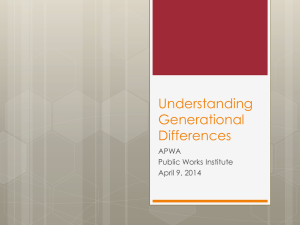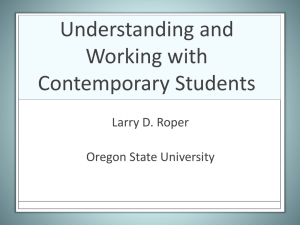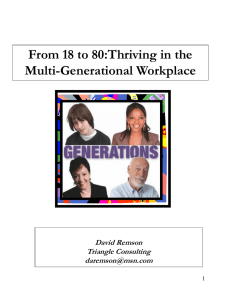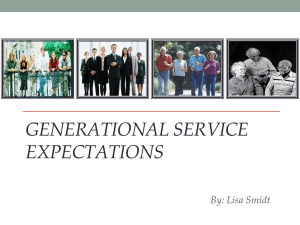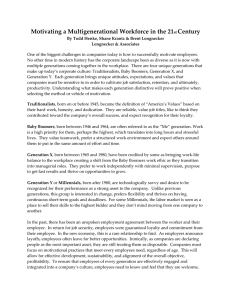Understanding the Multi-generational Workplace
advertisement
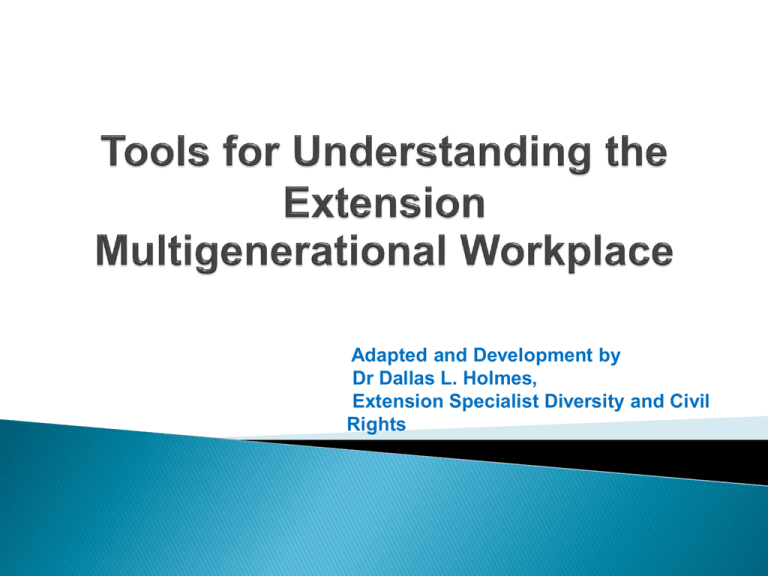
Adapted and Development by Dr Dallas L. Holmes, Extension Specialist Diversity and Civil Rights Goals for this diversity discussion are to help Extension educators and leaders: Understand and appreciate age diversity. Learn practical ideas on how to attract, motivate, and keep great employees of all age groups in the Extension organization. The labor force is at the lowest rate since the 1930’s and the US birth rate continues to decline. By 2025, 1 in 5 workers will be over age 55. The slowing of the workforce translates to an estimated shortfall of 20 million workers over the next 20 years. Adapted from: K. Tyler, Neckties to Nose Rings (2002) Employers will need to recruit and embrace diversity in the workforce. Companies must welcome retiree-age employees to remain on board and transfer skills. Adapted from: K. Tyler, Neckties to Nose Rings (2002) The fastest-growing occupations across developed nations are knowledge based, meaning the position requires formal education or advanced training. Given that knowledge is a scare resource; Extension must capitalize on it by inviting and nurturing the best people. Adapted from: K. Tyler, Neckties to Nose Rings (2002) Never before has there been a workforce and workplace so diverse in race, gender, and ethnicity. (Zemke, et al., 2000) We have four generations working side-byside in the Extension organization for the first time in history. All have unique experiences and attributes which influence their attitudes towards work. Adapted from: Recognition Management Institute, 2000 A group of people defined by age boundaries Those who were born during a certain era and share similar experiences growing up. They have common cultural or social characteristics and attitudes. Their values and attitudes, particularly about work-related topics, tend to be similar, based on their shared experiences during their formative years. Adapted from: Recognition Management Institute, 2000 Psychologists, sociologists, and everyday managers have identified important differences between these generations in the way they approach work, work-life balance, employee loyalty, authority, and other important issues. Notter Consulting, 2002 Some differences can be attributed to individual differences, such as levels of experience, levels of financial and family commitments, depth of personal development, political awareness, and emotional maturity. Source: www.aukland.ac.nz/uoa/about/news/articles/2005/11/generational_differences.cfm A lack of understanding across generations can have detrimental effects on communication and working relationships and undermine effective services. Dittmann, Generational Differences at Work, June 2005 Researchers have divided today’s workforce into four generations: Seniors, Veterans, Matures 1920-1944 Baby Boomers 1945-1960 Generation Xers, Twentysomethings, Baby Busters 1961-1980 Millennials, Generation Y’s 1981-2000 Generation Type Number in USA workforce Seniors/Veterans 42 million Baby Boomers 76 million Generation Xers, Twentysomethings, Baby Busters 54 million Millennials, Generation Y’s 75 million Source: Remson, Triangle Consulting (2006) Great Depression- Sacrifice and hard times World War II Social Security Mandatory Industrialization Korean War TV Civil Rights Movement Protests Rock and Roll Charismatic Leadership Baseball Heroes Larger than life politicians and Movie stars Man on the Moon Challenger Explosion Aids Video Games Latchkey Upbringing Personal Computers Political Scandal – Tell all biographies Repentant Religious leaders Internet- Technological integration Fall of Berlin Wall O. J. Simpson & Casey Anthony Trials Columbine and Norwegian Shootings September 11th Tragedy Iran and Afghanistan Wars- Global perspectives Some economic prosperity- Market melt downs Veterens Boomers Gen-Xers Millennials Loyal Loyal Adaptable to Goal-oriented Honors/Respects Optimistic Techno-savvy authority Follows Orders Formal Rewards later Practical Personal Sacrifice Civic Duty Responsible and Dedicated Team player Workaholic Personal gratification The “Me” Generation Material Acquisition change Techno-literate Self-starters Global mindset Informal Skepticism Self Preservation Individuality The “ Not Impressed” generation Prefers structure Enjoys much Skeptical Requires Technology- recognition Elder care absences Self-gratification Feel others owe supervision and support Sociable challenged Set in ways Difficulty with change them Motivation Child care absences Collaboration and Achievement important Optimistic Moral mindset Social activism More impatient Entrepreneurial Individuality Uniqueness More independent Traditionalist Baby Boomer Generation X Millennial 75 out of 100 90 out of 100 children reared children raised in a in a two-parent “traditional” home. home. ‘ 3 out of 100 children reared in a “traditional” home. “Traditional” home is nebulous term. Alternative lifestyles are openly acknowledged and tolerated. Traditionalist Baby Boomer Generation X Millennials Work the hours needed to get the job done (farm model) Average 55hours work per week for 40-hours pay ‘ Believes in 40- Work the hours work hours to get for 40-hours the job done. Set their own pay working hours “I get Saturdays off or I quit” Traditionalist Baby Boomers Generation X Millennials Dedicated to doing a good job Driven to do a good job Balance in home and work Determined to do a good job Work incorporated into home Traditionalist Hierarchy - Leadership Respectful - Authority Baby Boomer Consensus - Leadership Love Hate - Authority Generation X Competence - Leadership Unimpressed - Authority Millennials Teamwork – Leadership Respectful. but autonomous Issues of: Retention Recruitment Productivity Employee Satisfaction Customer Satisfaction History Culture ◦ Values, Beliefs ◦ Other…? Beliefs Behavior Results Employees of all generations have one thing in common. They need one good reason they should put their full faith in any one company. Trust is common, no matter the age. Adapted from: K. Tyler, Neckties to Nose Rings (2002) Bridging Differences Identify values Assess value differences Acknowledge implications Change behaviors Communicate needs Build on commonalities Accept differences Tap into motivations Manage Differences Set clear goals Share a common purpose Expect mutual accountability Give real recognition Adapted from: Recognition Management Institute, 2000 Find out what motivates them Find out what would cause them to leave the organization Treat them as they want to be treated People work for people not a company Hire the best person for the job Equip people with the necessary skills Adapted from: Recognition Management Institute, 2000 Make more time for orientation of new people Communicate goals clearly Demonstrate respect for the lives of others outside of the workplace Adapted from: Recognition Management Institute, 2000 Recognition is personal. Find out preferences for type of recognition. Recognition is about people and relationships, not things. Learn to say and show “thank you” in many different ways. Demonstrate that you trust people Making time for recognition is simply a choice. Adapted from: Recognition Management Institute, 2000 Ask people how they learn best. When people ask for the tools to do their work, give them the tools. Provide the latest technology as monies permit. Expect, plan for personal and professional development. Communicate about how well they are doing and where they can improve. Set goals and help with the plan to achieve them. Adapted from: Recognition Management Institute, 2000 Dittmann, (June 2005). Generational Differences at Work. Notter Consulting (2002). Generational Diversity in the Workplace. Tyler, K. (2002). Neckties to Nose Rings: Earning the trust of a MultiGenerational workforce: www.businessleader.com/bl/aug02/necktiestonoserings.html Remson, D. (2006). Thriving in the Multi-generational Workplace. Saunderson, R. (2000). Managing Generational Differences in the Workplace, Recognition Management Institute. Other Sources David Remson’s, November 2006 Brenda L. Romano, Managing Generations, International Builders Exchange Executives.
